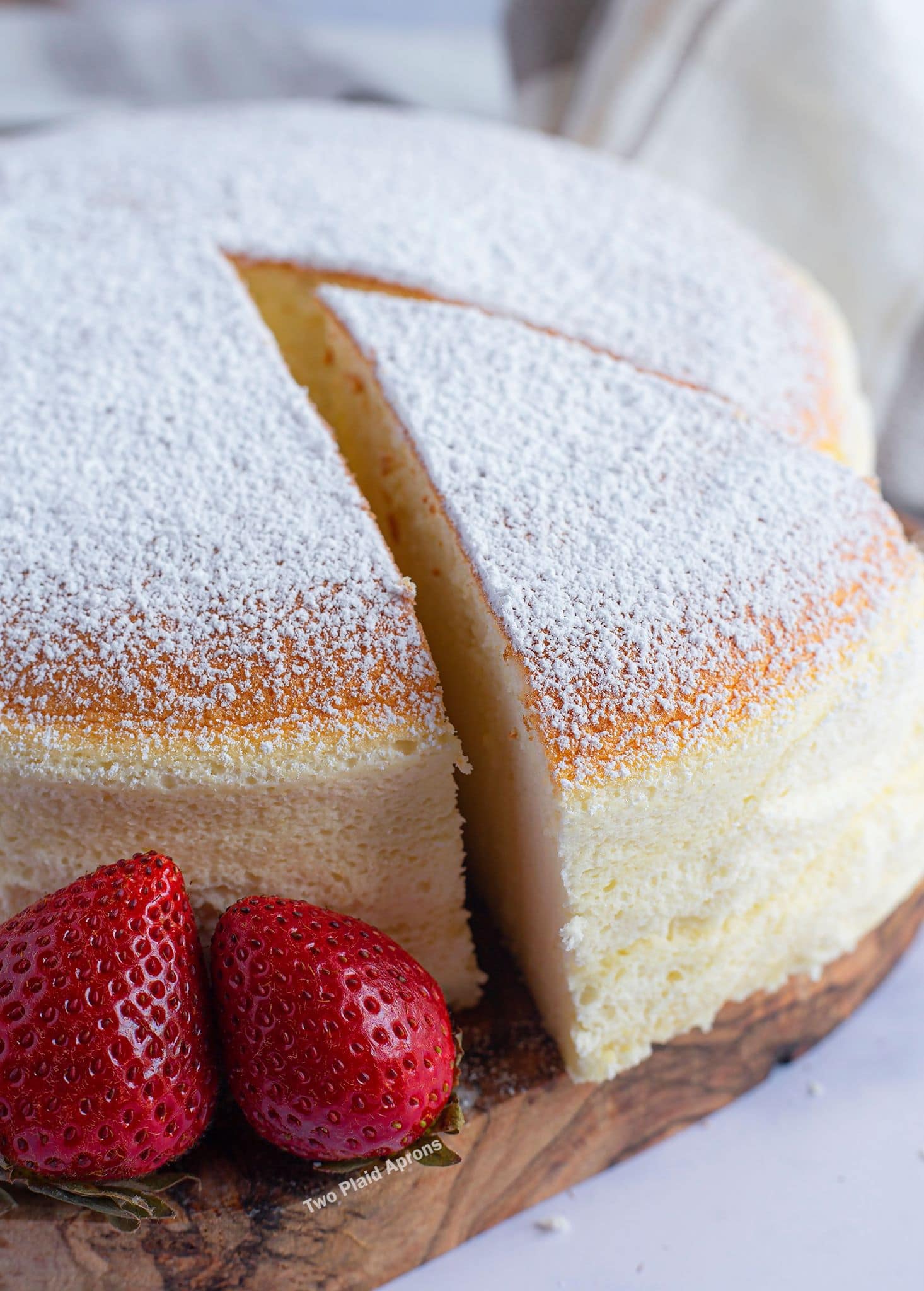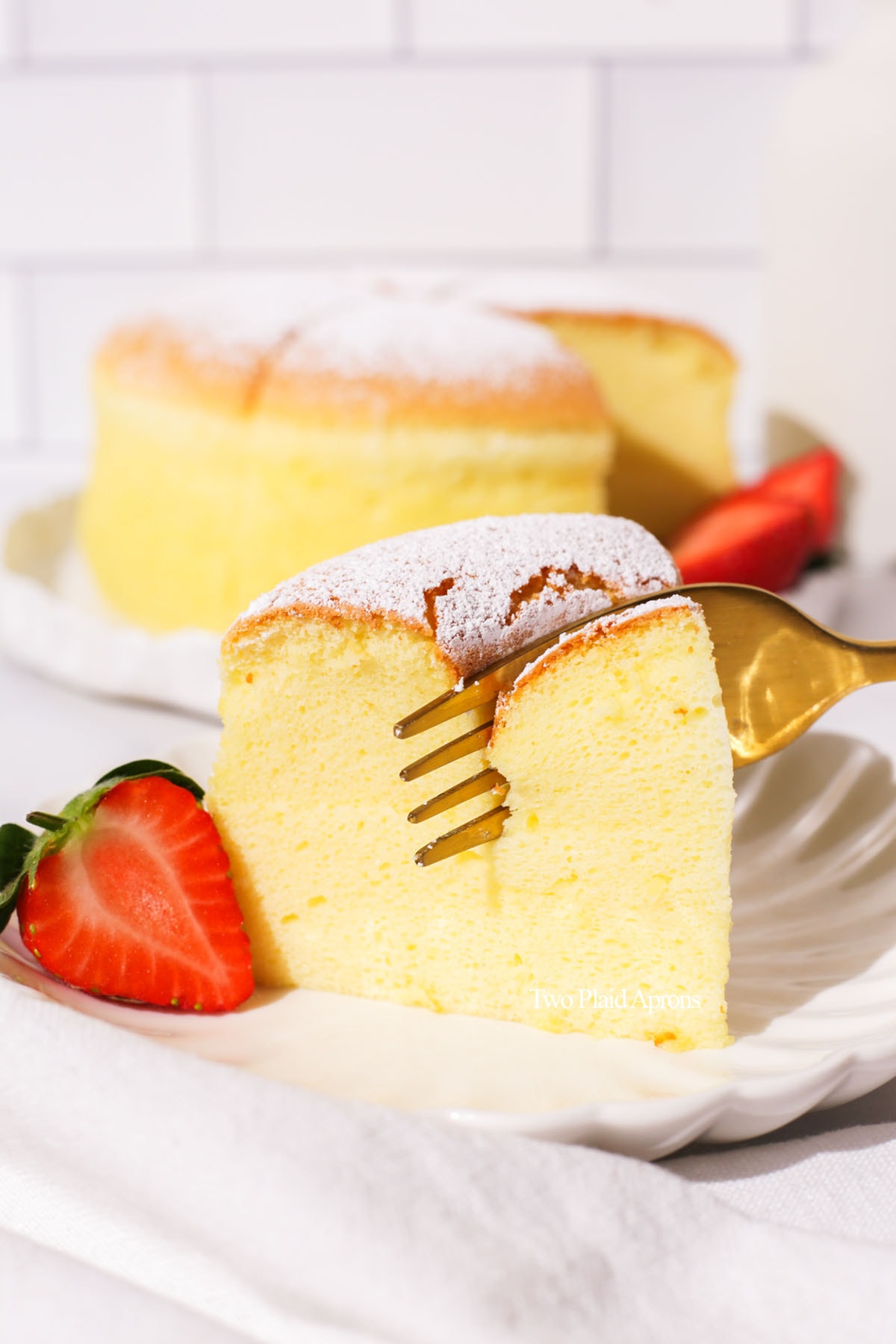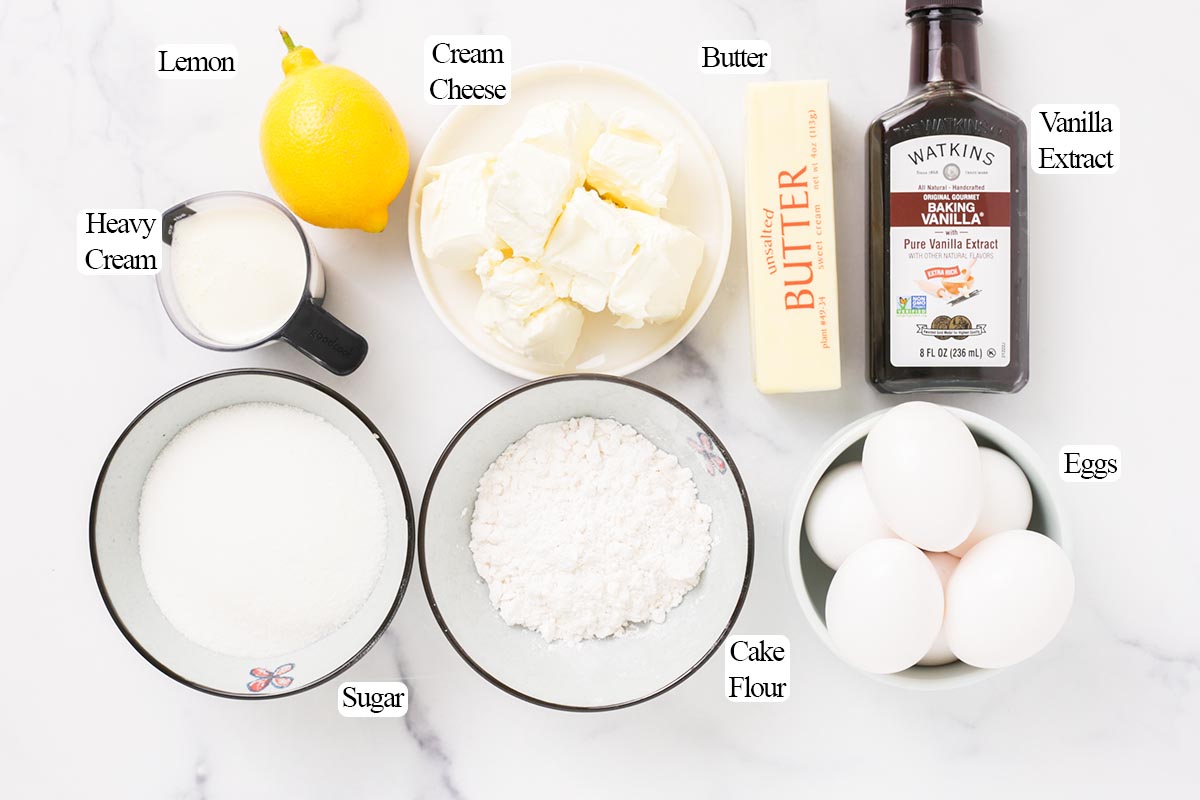This jiggly Japanese cheesecake is also known as Japanese cotton cheesecake. It's the fluffier, lighter alternative to classic cheesecake that tastes mildly sweet, slightly tangy, but still rich and creamy. Follow our recipe with step by step photo reference, tips, and extensive troubleshoot help to make this cheesecake perfect! Also, check out our ube basque cheesecake for a super creamy and easy cheesecake recipe.
What is Japanese cheesecake?
Ingredient notes
- Eggs - Our recipe measurement is based on large eggs. So please make sure to use large eggs or the cheesecake batter may not be the right consistency.
- Cream cheese - Full-fat cream cheese is best because it'll give the cheesecake the best flavor. We also recommend to have the cream cheese softened. So take it out of the fridge earlier.
- Heavy cream - We recommend using heavy cream because it's richer, which will give the cheesecake more richness. However, full-fat milk is a great alternative as well.
- Butter - Make sure to use unsalted butter and cut the butter into smaller pieces for easier melting.
- Cake flour - This ensures that the Japanese cheesecake stays tender and fluffy because cake flour has the least amount of gluten.
- Lemon zest and vanilla - These are optional flavorings that we highly recommend for the cheesecake. Lemon zest adds brightness and both are great flavor pairings for cream cheese.
- Sugar - Granulated white sugar and caster sugar is best for this recipe because the sugar dissolves faster.
- Lemon juice - This is for stabilizing the egg white for making meringue. You could also use some plain white vinegar instead.
- Optional toppings - Enjoy the Japanese cheesecake with berries, fruits, and whipped cream. You can also top the cheesecake with a dusting of powdered sugar or glaze the top with some apricot jam.
How to make Japanese cheesecake
4. Make the meringue. Combine egg whites and lemon juice and whip on medium high speed until frothy. While whipping, add the sugar, ⅓ at a time, before the meringue reaches soft peak stage. Reduce the speed to medium and continue whipping until meringue reaches medium-soft peak.
5. Combine the meringue and batter. Add ⅓ of the meringue into the base batter and gently fold until evenly combined. Repeat two more times to incorporate all of the meringue. Be gentle when folding to prevent deflating the meringue!
6. Bake the cheesecake. Pour the batter into the prepared cake pan and tap firmly to release large bubbles. Bake the cheesecake in a water bath for about 80 to 90 minutes or until the top is golden brown and a skewer inserted into the center comes out clean.
7. Remove the cheesecake. Dry the outside of the cake pan and place the cake pan onto its side, rotating it every 20 to 30 seconds, until the cheesecake completely pulls away from the pan. Flip the cheesecake out onto a plate and peel away the parchment paper on the bottom. Flip it upright onto another plate.
8. Enjoy. Let the cheesecake cool on the plate. Enjoy the Japanese while it's warm, completely cooled, or after chilling in the fridge for at least 1 hour.
Common troubleshoot
Here is a compilation of some of the most common issues we can across after many trials and errors of making Japanese cheesecake and the most likely reasons for these issues:
Deflated Cheesecake
Japanese cheesecakes have the tendency to shrink a bit after being removed from the oven and that's totally okay. It's because the cheesecake is a meringue based dessert, like our flourless chocolate soufflé and Taiwanese castella cake. However, the cheesecake should not deflate drastically.
- Under-whipped meringue - The softer the peak the meringue is, the jigglier the cheesecake will be, that is, if the meringue is at least whipped to soft peak. However, that also means that the cheesecake will deflate more. Besides appearance, the cheesecake will still taste good and have good texture.
- Over-whipped meringue - If your meringue is whipped past medium soft peaks, you'll likely see that the cheesecake will rise higher and that also means that it will deflate more.
- Undercooked cheesecake - If the cheesecake is undercooked, the interior structure will not be stable enough to hold the weight of the whole cheesecake. Make sure the oven temperature is at 300°F. Use an oven thermometer for best accuracy. To check if your cheesecake is cooked, insert a skewer into the center and it should come out clean or with only a couple of cake crumps.
- Parchment paper - If you lined the sides of the cheesecake with parchment paper, the sides of the cheesecake will likely be crinkled when the parchment paper is removed. This is due to the humidity and moisture. The imperfection on the sides of the cheesecake will not affect its tastes but will cause the cheesecake to deflate a bit more.
Cracked cheesecake
- Over-whipped meringue - If the meringue is whipped past medium soft peak, there's a higher tendency for the cheesecake to crack. This is especially common if the meringue is whipped to stiff peaks. Make sure to not whipped the meringue past medium soft peaks.
- Oven temperature is too high - If the oven temperature is too high, the exterior of the cake will set and brown before the interior has the chance to expand more. Use an oven thermometer to ensure that the oven's interior temperature is at 300°F.
- Oven rack is too close to heating element - We usually bake cakes in general on the middle rack in the oven. But when we moved, we noticed that that our Japanese cheesecake cracks no matter what we did and what temperature we baked it at. We experimented and found out that in some ovens, the top of the cheesecake cake is simply too close to the top heating element, which makes the cheesecake crack. If you have the same issue, move the baking rack from the middle to about 3 inches lower.
- Water bath not used - The purpose of the water bath is so that the cheesecake can bake gently and is an important factor in preventing cracks. Because water never heats above 212°F, that means the sides of the cheesecake will bake at a lower temperature. The moisture from the water bath also keeps the entire cheesecake from setting too early, which allows the cheesecake to rise to its highest potential. Make sure to have enough water in the water bath to reach at least ⅓ of the way up the side of the cake pan.
Cheesecake has dense layers
- Over-whipped meringue - Meringue whipped past medium soft peaks have the tendency cause separation in layers in the cheesecake. It's not because of the meringue itself, but because stiff peak meringue is harder to properly incorporate, leading to an over-mixed batter.
- Over mixed batter - With meringue based batter, it is crucial to not over-mix. Over-mixing the batter will deflate the meringue, creating a dense cake and separation in the Japanese cheesecake. That's when you see a super dense layer of rubbery cake, usually at the bottom.
- Oven temperature is too low - If the oven temperature is too low, the cheesecake will not bake properly. By the time the cheesecake is cooked, the air from the meringue will have escaped. This will make the cheesecake have separation in layers and dense layers.
Uneven crumbs (bubbles)
- Meringue has a lot of large bubbles - We recommend that the meringue be whipped on medium speed once the sugar has been all added. A lower speed helps to make finer meringue bubbles. It'll take a little longer, but the batter will look super glossy and smooth.
- Batter has a lot of large bubbles - Sometimes no matter how gently the meringue is folded into the batter, there will be large bubbles. To remove large bubbles, tap the cake pan on the table a couple of times or use a skewer to go in circles in the batter to pop some bubbles.
- Oven temperature is too low - If the oven temperature is too low, the air bubbles from the meringue will slowly escape and rise to the top of the cheesecake. If the temperature is significantly lower than 300°F, the cheesecake will have lots of huge air pockets at the top and denser layers on the bottom.



Comments
Post a Comment